The Tolls of Queensland
'Pushing the Envelope'
Dave Elsmore
For many years now I have collected toll tickets from Australia believing them to be revenue stamped paper, after further researching the group of tickets I have, I have found only two such bridges where the tolls were in Government hands [fig 7&8] and the tax was collected by the municipal council, the others [fig 1-6] were franchised to the bridge/road builder, this is still a grey area in the exhibiting arena but if the subject is treated correctly and within the revenue criteria it will be acceptable. But let me first start at the beginning.
Under the Moore government in 1929-32, a new system of tolls was introduced to meet some of the difficulties of finance. Tolls were applied in three different ways.
First, there were some roads already built where for special reasons the costs of maintenance were too high for the local authority, and a toll was introduced to cover maintenance costs. The Tamborine Mountain Road [fig1] the Pacific Highway [fig2] the Caboolture-Bribie Island [fig3] and the Mt Nebo Road [fig4] were in this category.
The Tamborine Mountain Road

Fig1
--------
Pacific Highway

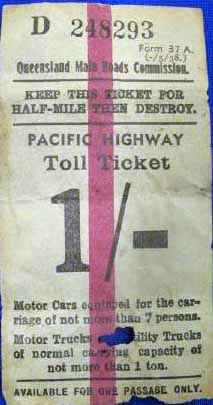
Fig 2
The right graphic 1/- Toll Ticket is courtesy of Queensland Museum
-------
Caboolture-Bribie Island

Fig 3
--------
Mt Nebo Road

Fig 4
---------
Indooroopilly Toll Bridge
The second category of tolls were bridges built by private enterprise, where a company was given a franchise to construct a project with its own funds in return for the right to levy a toll for a certain number of years, after which the project reverted to government control. The two most important examples were the Walter Taylor Bridge at Indooroopilly [listed on the stock exchange at the time] [fig5] and the Hornibrook Highway at Sandgate [fig6].

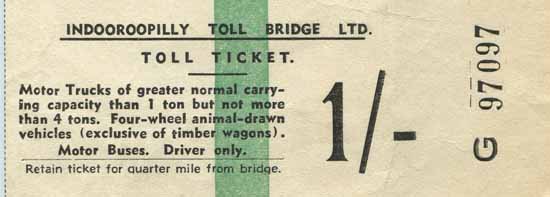
Fig 5
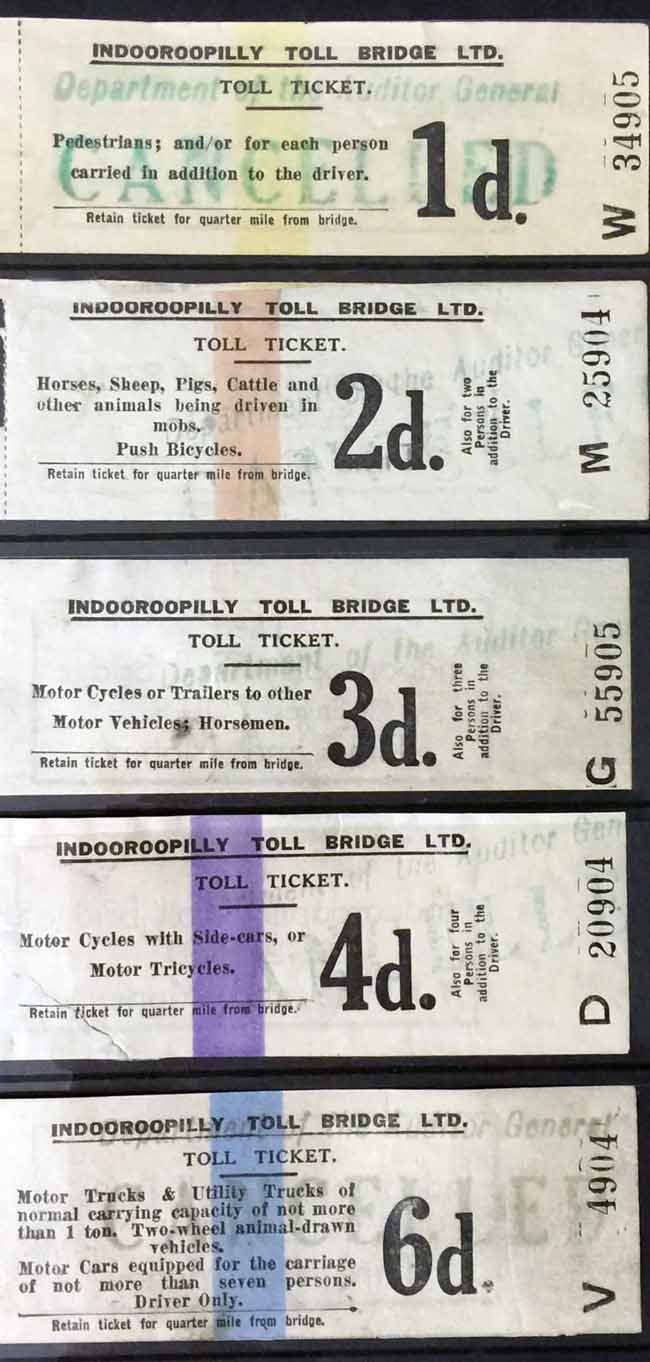
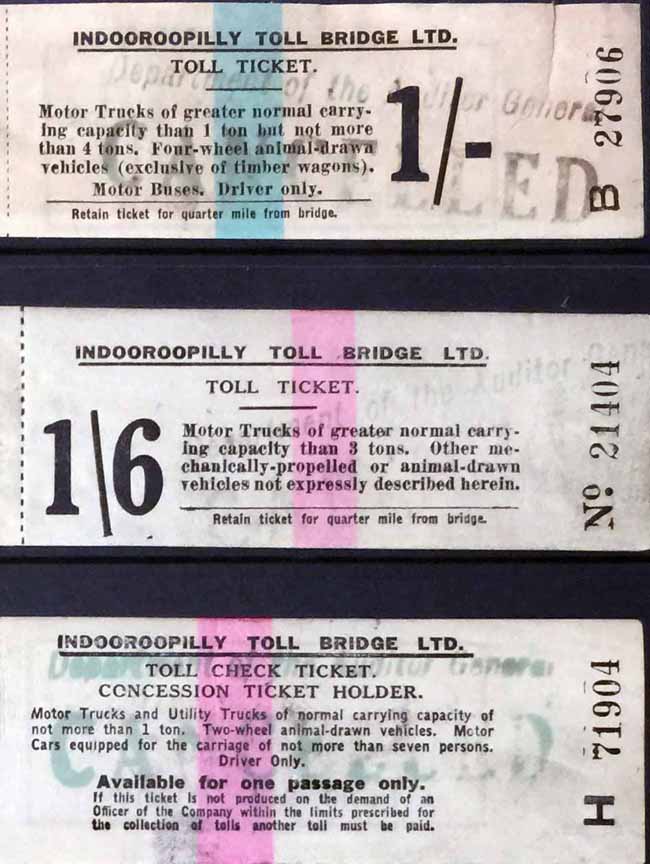
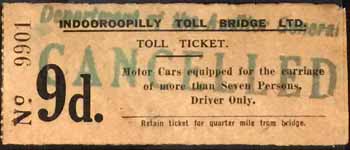
--------
Hornibrook Highway



Fig 6
--------
Logan River Bridge

Fig 7
Thirdly, there were projects initiated by the government itself, where tolls were imposed to help recover the cost: the Logan River Bridge [previously known as 'Loganholme Bridge'] on the Pacific Highway south of Brisbane [fig7] and the Story Bridge [fig8].
--------
Story Bridge

8 Fig
-------
None of the tolls in the first category was very significant, and the money raised was used to offset maintenance costs on the roads concerned. The same system was introduced on the Tamborine Mountain Road, which raised £394 in its first year of operation, late 1930-32. “In general,” the Annual Report noted in 1932“,tolls upon tourist roads are justified, as with this type of road the rateable values are small, and it would be impossible for the local users of the road and landowners to pay for it.”
The second category of private toll franchises was much more contentious. The depression made governments look more closely at alternative methods of funding, and tolls were a logical development, particularly in the case of bridges which replaced private ferries where a toll had previously been imposed anyway. The most famous example in the period was the Sydney Harbour Bridge, opened as a private toll bridge in 1932. But the process by which Hornibrook and Taylor acquired their franchise rights aroused considerable political debate. At a time of depression, the government was pleased to encourage such large capital works, with their promise of relieving unemployment. But no public tender was called for either project, and the Labour opposition made known its hostility to the general principle of privately funded tolls. The franchises were granted by Order in Council on 21 November 1931.
One problem was the difficulty of calculating the length of the franchise period during which a private toll would be levied, before the facility reverted to the state. The other, more general problem was that the distinction between private and public aspects of the construction sometimes overlapped. At the Indooroopilly Bridge, for instance, the design of the central span, 600 feet [183 meters] in length between centers, “necessitated much work in checking the design to an extent and with a responsibility as great as if the design had originated in the Commission office”. There was also the possibility that such a bridge, by diverting traffic flows into new patterns, would lead to further associated costs for local authorities or the government. Thus though the two projects were private, they were built under close supervision by the Main Roads Commission. The Hornibrook Highway, costing £265,210, opened in October 1935 and the Indooroopilly Bridge, costing £123,000, the following February.
The third category of tolls (and it is here in this category in which lies the interest to the revenue collector) was levied on government projects and included the Logan River Bridge and the Story Bridge, both built by the Main Roads Commission. The Logan Toll Bridge opened for traffic at midnight on 30 June 1931. It filled the last gap on the main South Coast road between Brisbane and the New South Wales border.
Bill Cock (a local resident) recollected the road in the 1930s: “It was in the 30s, because I was a kid, and we used to go to Burleigh for our holidays. And I remember one Easter, we left Brisbane about 11 o’clock on Thursday to beat the holiday rush so that we could get over the ferry at the Logan, and when we got there, my brother and I walked along and there were 128 cars lined up, and the ferry was taking 8 at a time. And then, of course, it was a flat-out trip to Oxenford, to the next ferry. Well, you could get round it by going up, round Russ Hinze’s place, but it was an ordeal to drive off the highway and over the Coomera at the crossing there, so very few people tried that sort of tactic”.
The Coomera Bridge was built first, and when that was done, the ferry from the Coomera was transported up to the Logan, hooked on and it became a 16 car ferry.
The franchise on the operation of the toll on the new Logan Bridge was auctioned by the government for £11,000, but when the franchisee withdrew from the agreement, the Commission took over the collection. This proved to be a windfall. In its first full year of operation, the bridge took tolls of £9767. When the Labour Party returned to power in 1932, the toll was too valuable a source of revenue for the Labor government to remove it, despite its earlier philosophical objections to tolls on public utilities. During the depression, tolls were accepted by members of the public since they allowed facilities to be built that could not otherwise have been started, and taxed the user, many of whom came from interstate, rather than the Queensland public at large.
By 1936, however, attitudes were becoming less sympathetic. The Courier-Mail described the bridge as a “portcullis on the Logan River, by means of which friends and strangers alike are made to pay tribute for the use of one of the principal arterial roads of the State”, and estimated that it had paid for itself twice over: built in 1931 for £25,796, net revenue from tolls by mid-1936 amounted to £55,649. Indeed it seems that about this time, Kemp indicated that the funds being collected were not only to cover the costs of constructing the Logan River Bridge, but for the whole of the Pacific Highway.
The second, much larger, government toll bridge was the Story Bridge. The first discussions regarding a bridge at Kangaroo Point began in 1926 then referred to as the “Kangaroo Bridge”, when a Cross River Commission was appointed by the Brisbane City Council to advise on ways of relieving traffic congestion at Victoria Bridge. The Commission recommended a bridge at Kangaroo Point, but the Council chose instead to build the Grey Street Bridge from the City to South Brisbane. Plans for a bridge at Kangaroo Point lapsed until 1931, when the builders of the Sydney Harbour Bridge, Dorman Long and Co., were searching about for a project to start after their Sydney work ended. They approached the Moore government with a proposal for a private toll bridge on a similar basis to the Harbour Bridge. The Dorman Long suggestion was considered during 1931, but in the last months of the Moore government, Bradfield, who had been the engineer on the Harbour Bridge, approached Kemp with an alternative proposal for a bridge to be built by a British consortium. The final decision, in 1933, was for a cantilever bridge based on one built in Montreal Canada in 1930, to be designed by Bradfield. The tender was won by Hornibrook and Co. Other engineering firms, including Evans Deakin, were also involved. By this time, the Moore government had fallen, and the Labour government was opposed to private tolls. Therefore the government, through the Department of Public Works, organised the project. The cantilevered bridge was a major engineering feat for the time in Queensland, involving digging foundations for the piers to a depth of 100 feet [30.5 meters] below the water level, using a system of airlocks, and teams of workers working in shifts under high air pressure. Unlike the Logan Bridge, which filled an obvious gap in the Pacific Highway, the Story Bridge was built without any clear demand, as a ‘make-work’ project. It was only with the coming of the Americans in World War II that traffic use grew to a significant level. It then quickly paid for itself and the toll was lifted in 1947, well ahead of schedule.
--------
Victoria Toll Bridge
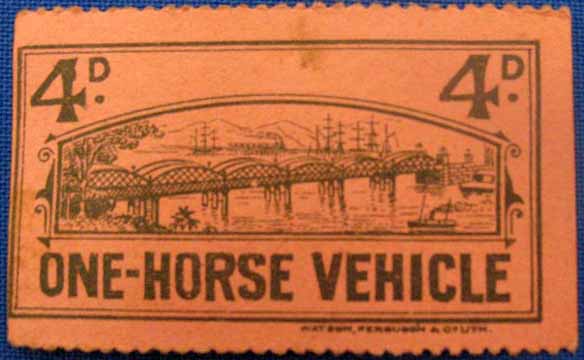
This toll ticket was for the passage of one horse-drawn vehicle across the Victoria Bridge, Brisbane, at a cost of 4d.
The above red graphic for the 4d Toll Ticket is courtesy of Queensland Museum
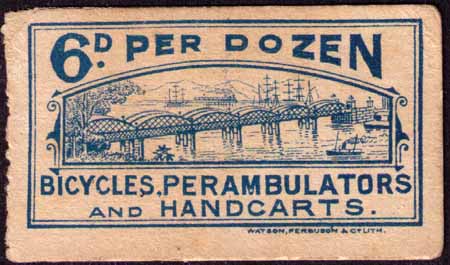
This toll ticket was for the passage of one Bicycle, Perambulator or Handcart across the Victoria Bridge, Brisbane, at a cost of 6d for 12 tickets – a 50% saving on the regular 1d toll.
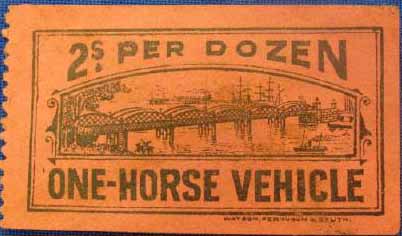
The above red graphic for the 2s per Dozen Toll Ticket and below legend is courtesy of Queensland Museum
This toll ticket was for the passage of one horse-drawn vehicle across the Victoria Bridge, Brisbane, at a cost of 2/- for 12 tickets – a 50% saving on the regular 4d toll. Tolls to cross the Brisbane River began with the construction of the second Victoria Bridge in 1874.
The Victoria Bridge depicted on the ticket was the fourth structure to cross the Brisbane River at that location. The first timber bridge, built in 1865, lasted two years before being destroyed by marine borers. The second bridge was completed in 1874 and named after the ruling British sovereign, Queen Victoria. It was destroyed by flood in 1893. A third bridge was erected that year, but it was destroyed by floods three years later. The fourth bridge, pictured on the ticket, was opened in 1896. Constructed of iron with stone abutments at each end the bridge was used by horse-drawn traffic, trams, pedestrians and later motor vehicles, until it was demolished and replaced by the current Victoria Bridge in 1969. The stone abutments of the 1896 bridge are still in place on the river banks.
The ticket was designed and printed by Watson, Ferguson and Co. Queensland’s longest running printing company, established in 1868 and still operating today.
--
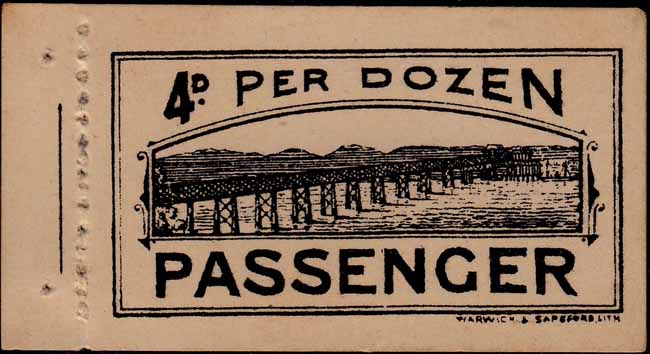
4d per Dozen Toll Ticket, c1888. New printer imprint lower right, "Warwick & Sapsford, Lith"
Warwick & Sapsford, printers & lithographers Eagle St Brisbane.

1/6d per Dozen Toll Ticket, c1888. Imprint lower right, "Warwick & Sapsford, Lith"
Warwick & Sapsford, printers & lithographers Eagle St Brisbane.
Other tickets awaiting to surface are : One Horse Vehicles : Two Horse Vehicles : Additional Horse : Bicycles : Sheep : Pigs, Goats.
Sheep, Pigs & goats were only permitted to cross the bridge from 11.30pm to 6.30am.
-----
References. 1. G. M., Memo for Mr. Kemp, 28 November 1930. 2. Minute, J. R. Kemp, 29 November 1930. 3. MRD 210/7/2/4. 4. Brisbane Courier, 16 January 1930. 5. Brisbane Courier, 18 January 1930. 6. Brisbane Courier, 25 January 1930. 7. MRD 231/3. 8. Brisbane Courier, 31 January 1930. 9. The Tolls on Privately Constructed Road Traffic Facilities Act of 1931. 10. Main Roads Commission Annual Report, 30 June 1933. 11.Brisbane Courier, 14 July 1936. 12. Brisbane Courier, 7 January 1937. 13. “From Bull Dust to Beef Roads and Beyond”. Undated Main Roads. Queensland Museum Registration numbers for H13303, H9909 & H 9910.
The Tickets
Fig 1. Tamborine Mountain Road. Form 37 A (-/7/30 & -/11/30) Up & Down. Fig 2. Pacific Highway Form 37 A (-/7/40). Fig 3. Caboolture-Bribie Island Road Toll. Fig 4. Mt. Nebo Road Enoggera Form 37 A (-/2/39). Fig 5. Indooroopilly Toll Bridge Ltd. (Walter Taylor Bridge). Fig 6. Hornibrook Highway Ltd. Fig 7. Logan Bridge. Queensland Main Roads Commission. First 3 series one Form 37 A (-/6/31 & -/8/31). Series two Form 37 A (-/12/31 & -/3/33). Fig 8. Story Bridge. Bureau of Industry, 1d 3d 6d 9d Form B1. 6d Concession Check ticket (hawkers’ vehicles were registered at a concession rate) 9d Return, both Form B1.
© copyright 1997 on
All Graphics. Dave Elsmore
No part of this page may be copied used, saved in electronic form or hard printed.